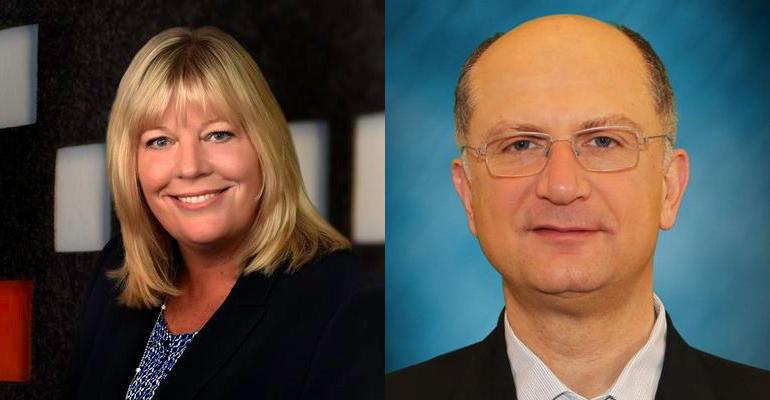Cheryl Nash, Fiserv’s president of investment services, is one of the leading voices in wealth management technology. She joined with Tirdad Shojaie from Fiserv’s product management, marketing and strategy division, to talk about the trends they’re seeing in financial advice.
WealthManagement.com: Let’s start off by discussing some of the wealth management offerings in the banking channel.
Tirdad Shojaie: You’ve got a lot of different type of banks that are in the business, and more and more of the retail banking channel is walking into wealth management. More banks want to take control of wealth offerings as part of a fully integrated user experience for the client, bringing banking and wealth together. There’s been a lot of activity in the digital world in terms of what we call “digital advice.” It’s mostly focused on working with a client to understand their personal preferences and having some high-level goals. It’s how the digital platform creates intimacy and personalization.
WM: Do digital advice platforms create a natural path into a bank’s offerings?
Cheryl Nash: Banks that have either a smaller footprint in wealth management or are just thinking about getting into wealth management see that investors or consumers are used to doing things online. There’s a very big need to have a very simple, nice client experience for those investors. Banks that aren’t in wealth today don’t necessarily understand what it takes to run a wealth management platform, so setting something up from a digital perspective allows the investor to get into the right instruments, according to their risk profiles, and is a good introduction for these particular banks to get into wealth management. They’re trying to figure out how to offer something without having all the infrastructure that a big bank has.
TS: When it comes to trying to service different segments of the market, from high-net-worth mass affluent to millennials who just started to work, the conversation around goals and financial planning is a very natural interaction. Everybody has some form of goals, whether it’s retirement, a child’s education, or a car, boat, house, whatever. So those kinds of interactions are very natural and applicable across different segments, and it lends itself nicely to a digital experience, which can be very simple, very unique and personalized. Digital advice allows the banks to get into the mix and have an interaction with their clients who already are doing the banking with them—allowing them to expand in terms of the client-bank relationship. It builds trust and retains more of the share of the wallet.
WM: Some in the industry see goal-based investing as a natural evolution in wealth management. Can that be automated or handled algorithmically? Or are we headed in a different direction?
CN: I think the industry is now at a point where it’s ready to embrace goal-based investing, and what we’re seeing is that it’s a big undertaking because the technology’s already there, but you also have to train advisors on how to talk to their clients in a different way. It’s a very different conversation to talk about how to invest against your goal versus how you pick stocks.
WM: What are some of the exciting prospects that analytics can provide us in the next year or next 18 months?
CN: This might be out a little bit further, but “personas” are something that we’ve been talking a lot about when we’re in front of our clients. A digital platform that has gathered a lot of data on investors can build personas and segment clients into how similar they are to others in the investor base. Things like age, number of children, where they live, how much money they make, those types of things, could come together and you could offer an investment, a model, or something that similar investors are interested in. So there’s a lot of discussion around how you take data like that and make it usable. I think we’ll start seeing things like that down the road: persona-based and driving more intelligence about what people that look like you and act like you and live near you are doing today.
WM: In order to build those persona models, you need a lot of consumer data. How do you balance that against the need for security and responsible use of the consumer data itself?
CN: I think a lot of firms today are already pooling data. So you’re not necessarily giving anything away, right? You’re taking data that’s already out there and available and you’re putting it together like a pool. Those are the ways that you’re going to be able to do that at first. It’s being done all over the place today with Amazon and even Instagram and Facebook. But I think that’s going to be the next evolution when you think about data and data privacy. I don’t think we’re there yet, but we will get there.
WM: Is that a decade away?
CN: It’s years away. There are so many firms today that are 100 percent focused on data and artificial intelligence, and taking that data and figuring out what to do with that. So I don’ think it’s decades away. It’s pooled data; it’s more anonymous, so nobody can point to one person and say that’s the person I’m mimicking. It’s already happening today in other industries. I think it moves into our industry, not decades but years from now.
WM: You mentioned artificial intelligence. What are some of the new technologies that are emerging in the industry today and how are you seeing them being used?
TS: We do a lot of work around data strategy that ties back to our application to enable robotic process automation. And in parallel there’s a lot of activity and excitement around voice as the next user interface. That ties right back to artificial intelligence. People are teaching Alexa. We’re actually making the machines smarter. But the machine hasn’t really turned around and made us smarter. I think within 12 to 18 months you’ll see patterns there. Machines are learning because we’re providing more data to them from our domain, whether it’s an evaluation of a portfolio or keeping track of the progress toward a goal or a benchmark for a portfolio. The movement around robotic process automation, which makes humans more efficient, is going to move a lot faster for our industry and will have more impact in the next 12 months.
WM: What are some of the areas in wealth management that technology has really struggled to address?
CN: Data. For all this technology in wealth management—platforms sitting on a ton of data—you really need to make sure that that data is clean and actionable and has the right governance around it. That’s one of the big things the industry is struggling with and some firms are spending a lot of money figuring that out.
And while things are moving so quickly in technology, our clients tell us that the regulatory pressures and subsequent cost pressures that they’re under gets in the way of them having a budget that’s really focused on innovation. Think about how much money the industry spent on DOL, for example. It was good for our industry, but I think that was a big regulatory spend. Even what’s happening with GDPR right now. There are so many changes happening and being pushed on this industry, it’s a big spend that gets in the way of putting money towards more innovation.
WM: Any last thoughts on technology in financial services?
CN: If you think about the wealth transfer generated by baby boomers retiring and $30 trillion getting transferred to Gen X and millennials, it makes sense why banks and these other firms are really focusing on a very simple, easy digital experiences to manage that. You need to be ready for that when wealth goes from clients to the clients’ kids.
Also, women are becoming much more focused on investing. And they’re the ones that are living longer. They’re the breadwinners today. They’re inheriting money and they need to figure out how to invest it. You want to make sure from a fiduciary perspective that you’re giving your clients the right models to match their risk. I think technology can help build solutions against the personas that drive what a particular segment of investor is looking for, both from the advisor and the digital platform.
There’s just a whole slew of things that are coming our way and we’re at the forefront of changing how this industry’s running and there are so many different opportunities from digital to data to artificial intelligence that are going to be able to help our industry get to that next level.
Interview was edited for length and clarity.




